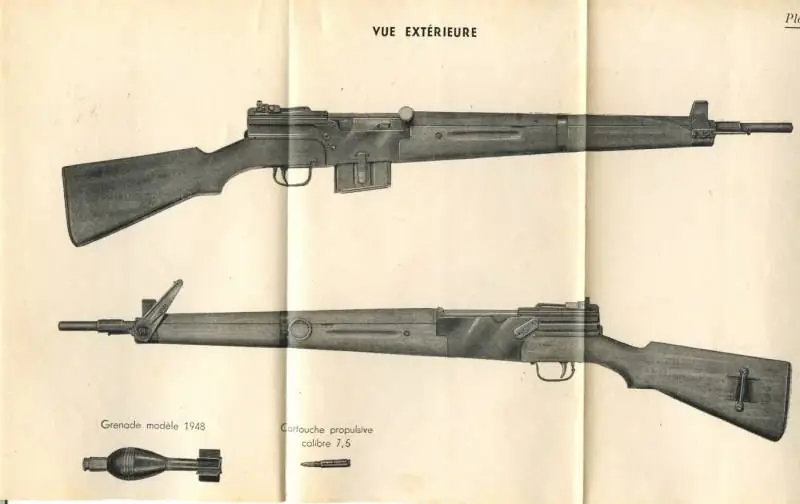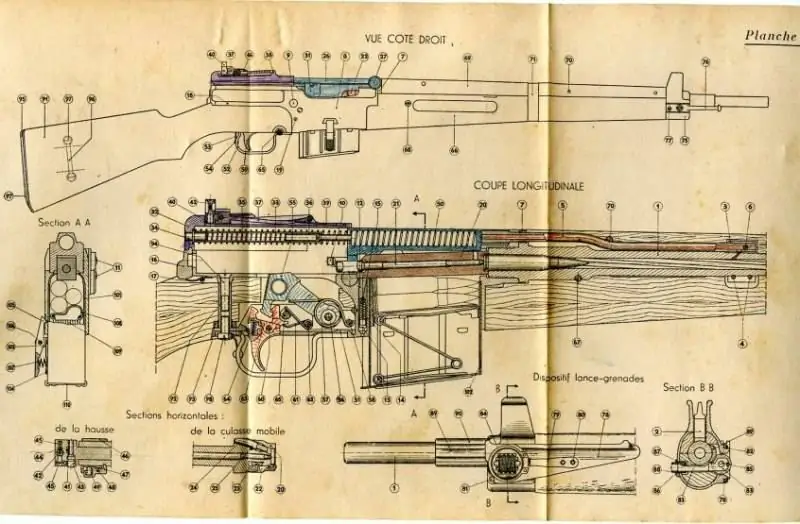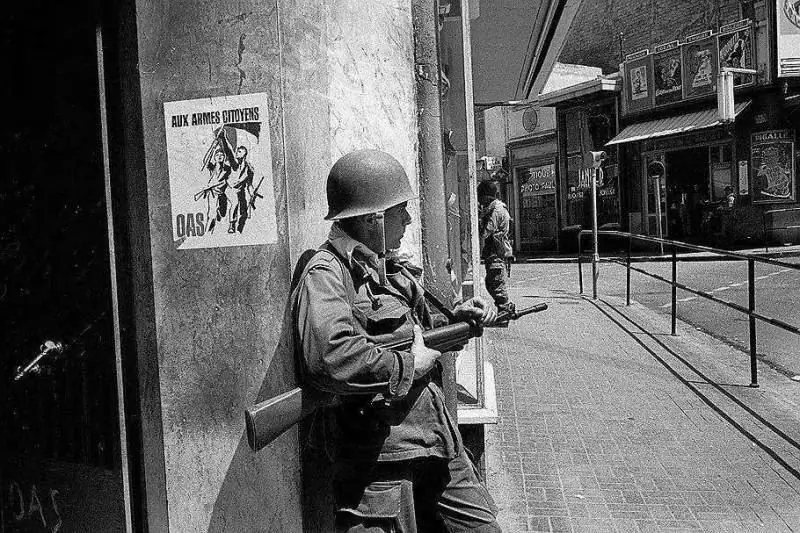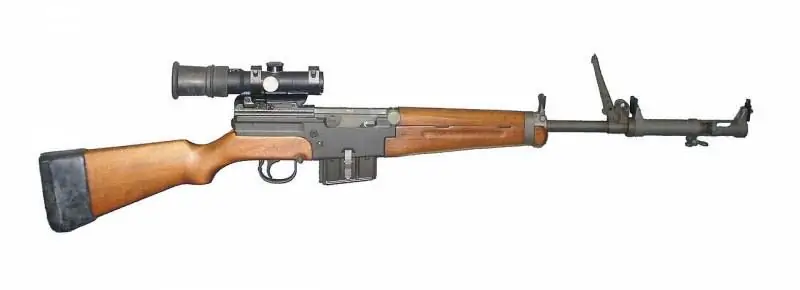- Author Matthew Elmers [email protected].
- Public 2023-12-16 21:49.
- Last modified 2025-01-24 09:17.
With the end of World War II, the French army faced the need for rearmament, and here it turned out that the French were lucky to a certain extent. It was fortunate that their soldiers had to become familiar with many types of weapons, including the Garanda M-1 automatic rifle and the M-1 carbine, and possibly also German assault rifles. That is, they got to know this type of weapon in practice, could evaluate it and see all the pros and cons of these systems. That is why they chose a modern self-loading rifle, and their own, although they could have borrowed the American "guaranty". Note that it was in France that work on the creation of self-loading rifles has been carried out since the end of the 19th century, and not without success. Therefore, as soon as France freed itself from the German occupation, in the same 1944, the engineers of the state arsenal in the city of Saint-Etienne - Manufacture Nationale d'Armes de St-Etienne (MAS), based on previous developments, in a fairly short time created a self-loading rifle MAS-1944. The rifle was released in an amount of about 6,000 copies and over the next years they were engaged in its improvements. As a result, the Fusil Automatique MAS-1949 rifle was adopted in 1949. Then in 1956 it was modernized and it became known as MAS-1949/56. In this version, it was used in the French army until the very end of the 1970s, when it was replaced by the FAMAS assault rifle, chambered for 5.56 mm NATO cartridge. Both rifles, MAS-1949 and MAS-1949/56, were actively used during the French wars in Indochina (Vietnam) and Algeria, and proved their high reliability, ease of use and high shooting accuracy.

Rifle MAS-1949. Drawing from the instruction manual. The lever of the shut-off valve of the gas mechanism is clearly visible, the archaic hook for setting into the box. Below is a rifle grenade and a 7.5 mm cartridge.
The French managed to create an original gas engine for the MAS-1949 rifle with a direct effect of powder gases on the bolt. This system was developed by the Frenchman Rossignol in the 20s of the twentieth century, but it was used much later, first in the Swedish AG-42 rifle, and then - after MAS-1949, it was also used by Eugene Stoner in his AR-15 / M16 rifles. The essence of the design lies in the fact that the gas chamber is located above the barrel, and the powder gases from it through the gas outlet tube (in the MAS-1949 it is not straight, but with a knee-like bend) enter the receiver. Here they press on the U-shaped bolt carrier, inside which the bolt in the form of a bar swings in a vertical plane. It is connected to the bolt carrier by means of a groove in the rear of the striker, which can be easily removed from the bolt itself. The bolt carrier is spring-loaded with a mainspring, put on the guide rod of the receiver cover. By the way, a sight is also installed on it, and it can be removed in almost the same way as the bolt cover of a Kalashnikov assault rifle. That is, with incomplete disassembly of the rifle, we get only five parts: the receiver cover, the return spring, the bolt, the firing pin and the bolt carrier. It is interesting that the cocking handle of the bolt carrier has a massive "head" made of plastic, which is certainly convenient from the point of view of ergonomics. USM conventional, trigger type, designed only for firing single shots. The fuse is made in the form of a transverse button in front of the trigger frame.

From top to bottom: MAS-44, MAS-49, MAS-49/56. The last rifle has become much shorter, it has changed the forend, sights and the place of attachment of the lever, the mechanism for cutting off the gas supply from the barrel.
Such a gas mechanism works in a very simple way. When fired, the powder gases rush back through the tube and press against the wall of the bolt carrier. She moves back, pulls back the firing pin and no longer presses on the bolt from above. At the same time, the rear part of the bolt warps, that is, it rises up, it disengages from the barrel and moves back even further, carried away by the bolt carrier, compressing the mainspring and at the same time removing the spent cartridge case from the chamber.
After that, the frame, pushed by the spring, moves forward. The bolt also goes forward, picks up the next cartridge, pushes it into the chamber, but since the frame now begins to press on it from above, its rear part goes down, and the front part, on the contrary, rises. The shutter tilts vertically. It is locked. After that, when the trigger is pressed, the trigger hits the striker retracted back, it breaks the primer and a shot follows. Then the cycle repeats. The design provides for the presence of a shutter delay, which stops the shutter in the extreme rear position when all the cartridges from the magazine are used up.

Diagram of the MAS-49 rifle.
So, as you can see, there are very few moving parts, which increases the reliability of the weapon. True, this simple system is fraught with the formation of carbon deposits. That is, weapons with direct gas supply to the receiver have to be constantly cleaned. But by cleaning the components of the gunpowder, it is possible to reduce the process of formation of carbon deposits, and, apparently, it was the French who managed to create such an ammunition that did not give a lot of carbon. In any case, the French soldiers armed with these rifles, judging by their recollections, did not particularly complain that they were cleaned from morning until evening, or that they often refused to shoot due to problems with carbon deposits. Here American soldiers with M-16 rifles in Vietnam complained about this constantly, or rather, until the ammunition manufacturer changed the recipe for the gunpowder in the cartridge. What they complained about was the large weight of the MAS-49 rifles, the mass of which, with a relatively small size, was 4.5 kg. By the way, it is not very clear why it was so heavy, because there seemed to be little metal in it. Most likely, its creators made them all as "thick" as possible to ensure its durability. Indeed, all reviews of the new French rifle began with the word "reliable".

A French soldier with an MAS-49/56 rifle in Algeria on March 19, 1962.
The supply of cartridges to the MAS-49 comes from a box magazine for 10 cartridges, in which they are staggered. Moreover, you can fill the magazine inserted into the rifle using clips for five cartridges each (for which there are guides for the clips), or you can simply change the shot magazines. Interestingly, the magazine latch is not on the receiver, as is usually done, but on the magazine itself on the right.
In the design of the rifle, certain parts were borrowed from the MAS-36, for example, the butt, forearm and sight. The front sight had the same muzzle and was located on the front stock ring, and the diopter rear sight was installed on the receiver cover. It can be adjusted both in range (from 200 to 1200 meters) and in elevation. MAS-1949 was equipped with a special rail for the telescopic sight bracket, located on the left side of the receiver wall. The rifle could also be used to fire rifle grenades that were worn on the barrel. In this case, special blank cartridges, a special grenade sight on the left side of the box and a gas cutoff were used. On the first samples of the rifle, at the very beginning, a hook was provided for setting the rifle into the trestle. But the bayonet on it, unlike the MAS-44 model, was no longer provided.

Algeria, 1962. Soldier with MAS-49/56 rifle.
The MAS-1949/56 model received a shortened barrel and forend, and its weight decreased by more than 0.5 kilograms. The sight for firing grenades and the base of the front sight were transferred to the barrel, the gas cut-off valve was placed at the front cut of the forearm directly above the barrel. A muzzle brake was placed on the muzzle of the barrel, which was also a guide for launching rifle grenades. The trestle hook has been removed from the rifle.

Sniper version of the MAS-1949/59 rifle.
The sniper variants MAS-1949 and MAS-1949/59 were equipped with an APX L Modele 1953 optical sight with a magnification of 3.85X. The effective range of aimed firing with them was equal to 600 meters.






